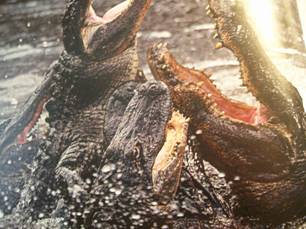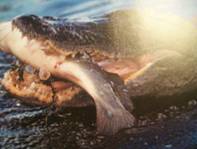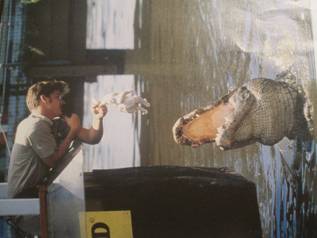
Articles
Alligator Farms
Characteristics
Conservation
Diet
Facts
Reproduction
Safety
American Alligator Diet
American Alligators, like all crocodilians, are carnivorous. Hatching, juveniles, and adults will eat a variety of insects. As they grow larger they will eat snakes, turtle, and snails. Slow - moving fish, small mammals, and birds are included in their diet. Larger adults sometimes take small calves and, very occasionally, people.
Feeding Time

Alligators are predators they live by killing and eating other creatures. They'll eat anything they can catch, from birds, snakes, and turtles, to animals as big as deer and cows.
Crocodilians do not have to hunt every day. A big meal can last them for several days.
Alligators and crocodiles cannot chew their food, so they have to swallow their prey whole or in big chunks.
An alligator lies like a floating log in the water and keeps watch for prey. If an animal comes close to the water's edge to drink, the alligator lunges forward with amazing speed to seize it. It drowns its prey before tearing it to pieces with its teeth
An alligator's jaws are strong enough to crush a hard - shelled creature such as a turtle.
Alligator also eat carrion-the remains of animals that are already dead.
In the summer, alligators eat lots of food and build up plenty of fat on their bodies. When the weather grows cool, they eat much less. They can go without food for weeks in the winter.
How gators Hunt

Alligators are very successful hunters. This is because an alligator hunts very quietly. It swims slowly along the shore, with just its eyes and nostrils peeking above the water's surface. It looks for prey that is in its size range, such as a turtle or bird. When an alligator has located its prey, it submerges itself underwater. Then it explodes out of the water in one quick burst. The gator grasps its victim in its jaws and drags it underwater to drown.
Sometimes an alligator will shake its head or spin its body while holding its prey. These movements help the alligator to rip chunks of flesh from a larger animal. Because alligators don't chew, they need to tear off pieces that are small enough to swallow. Alligators also may store their catch in their mouths. The victim's body will disintegrate, or fall apart. Then pieces of the animal can be torn off more easily. Alligators have to lift their heads out of the water to eat. Otherwise they will drown.
The alligator in this picture bellow is nearly hidden, with just its eyes and nostrils above water. Its waiting to ambush a bird, a fish, a raccoon, a turtle, or even a deer that could become dinner. The same way you inflate a raft, the gator can take air into its lungs to make its big body float. It can submerge to any depth by controlling the amount of air inside. Because its nostrils, ears, and eyes are on top of its head, the alligator can have the rest of its body hidden and still breathe, hear, and look around.

The only time it's safe to feed an alligator is if you are a professional. Here, a keeper feeds a dead chicken to an alligator at Florida's Gatorland.
